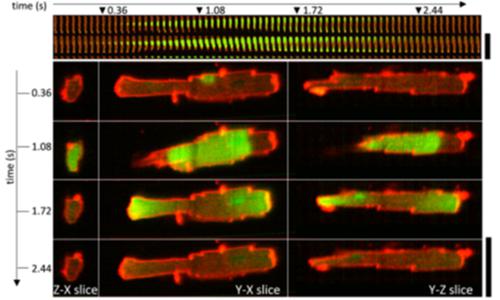当前位置:
X-MOL 学术
›
J. Biophotonics
›
论文详情
Our official English website, www.x-mol.net, welcomes your
feedback! (Note: you will need to create a separate account there.)
Development a flexible light-sheet fluorescence microscope for high-speed 3D imaging of calcium dynamics and 3D imaging of cellular microstructure.
Journal of Biophotonics ( IF 2.0 ) Pub Date : 2020-03-12 , DOI: 10.1002/jbio.201960239 Hugh Sparks 1 , Liuba Dvinskikh 1, 2, 3 , Jahn M Firth 3 , Alice J Francis 3 , Sian E Harding 3 , Carl Paterson 1 , Ken T MacLeod 3 , Chris Dunsby 1, 4
Journal of Biophotonics ( IF 2.0 ) Pub Date : 2020-03-12 , DOI: 10.1002/jbio.201960239 Hugh Sparks 1 , Liuba Dvinskikh 1, 2, 3 , Jahn M Firth 3 , Alice J Francis 3 , Sian E Harding 3 , Carl Paterson 1 , Ken T MacLeod 3 , Chris Dunsby 1, 4
Affiliation

|
We report a flexible light‐sheet fluorescence microscope (LSFM) designed for studying dynamic events in cardiac tissue at high speed in 3D and the correlation of these events to cell microstructure. The system employs two illumination‐detection modes: the first uses angle‐dithering of a Gaussian light sheet combined with remote refocusing of the detection plane for video‐rate volumetric imaging; the second combines digitally‐scanned light‐sheet illumination with an axially‐swept light‐sheet waist and stage‐scanned acquisition for improved axial resolution compared to the first mode. We present a characterisation of the spatial resolution of the system in both modes. The first illumination‐detection mode achieves dual spectral‐channel imaging at 25 volumes per second with 1024 × 200 × 50 voxel volumes and is demonstrated by time‐lapse imaging of calcium dynamics in a live cardiomyocyte. The second illumination‐detection mode is demonstrated through the acquisition of a higher spatial resolution structural map of the t‐tubule network in a fixed cardiomyocyte cell.
中文翻译:

开发一种灵活的光片荧光显微镜,用于钙动力学的高速 3D 成像和细胞微观结构的 3D 成像。
我们报告了一种灵活的光片荧光显微镜(LSFM),旨在研究心脏组织中高速 3D 动态事件以及这些事件与细胞微观结构的相关性。该系统采用两种照明检测模式:第一种使用高斯光片的角度抖动与检测平面的远程重新聚焦相结合,以进行视频速率体积成像;第二种模式将数字扫描光片照明与轴向扫描光片腰部和阶段扫描采集相结合,与第一种模式相比,提高了轴向分辨率。我们提出了两种模式下系统空间分辨率的表征。第一种照明检测模式以每秒 25 个体积的速度实现双光谱通道成像,具有 1024 × 200 × 50 体素体积,并通过活体心肌细胞中钙动力学的延时成像得到证明。第二种照明检测模式是通过获取固定心肌细胞中 T 管网络的更高空间分辨率结构图来演示的。
更新日期:2020-03-12

中文翻译:

开发一种灵活的光片荧光显微镜,用于钙动力学的高速 3D 成像和细胞微观结构的 3D 成像。
我们报告了一种灵活的光片荧光显微镜(LSFM),旨在研究心脏组织中高速 3D 动态事件以及这些事件与细胞微观结构的相关性。该系统采用两种照明检测模式:第一种使用高斯光片的角度抖动与检测平面的远程重新聚焦相结合,以进行视频速率体积成像;第二种模式将数字扫描光片照明与轴向扫描光片腰部和阶段扫描采集相结合,与第一种模式相比,提高了轴向分辨率。我们提出了两种模式下系统空间分辨率的表征。第一种照明检测模式以每秒 25 个体积的速度实现双光谱通道成像,具有 1024 × 200 × 50 体素体积,并通过活体心肌细胞中钙动力学的延时成像得到证明。第二种照明检测模式是通过获取固定心肌细胞中 T 管网络的更高空间分辨率结构图来演示的。












































 京公网安备 11010802027423号
京公网安备 11010802027423号